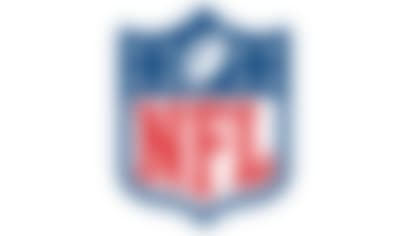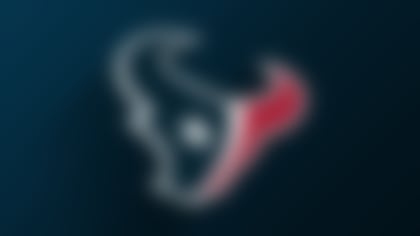The Pro Football Hall of Fame's Class of 2018 will be introduced during the NBC broadcast of "NFL Honors," which begins at 9 p.m. (ET and PT) on Feb. 3, the eve of Super Bowl LII.
As he did with the Class of 2017, NFL.com's Elliot Harrison has found a key film illustrating just what made each of the 15 modern-era finalists for the Class of 2018 worthy of consideration for pro football's ultimate honor. Below, you'll find one instructive video clip containing one or more plays that encapsulate each finalist's greatness. (Note: The same videos and explanations were used for some of the players who were also finalists for the Class of 2017.)
Nobody's turkey: Randy Moss
Forget the record-breaking season with the Patriots in 2007. Or the giant afro and gargantuan numbers in 2003. The blind flip that looked more like a H-O-R-S-E shot from your grandpa's backyard hoop to Moe Williams was neat. Who could forget him beating Darrelle Revis -- back when Revis Island was still a thing -- by a country mile, then catching the ball with one hand?
All of that is nice. And sweet. Yet, the reason people (voters) consider Randy Moss a first-ballot Hall of Famer is because he was so good right out the gate. The embodiment of his first-year dominance came on Thanksgiving Day 1998 at Texas Stadium, when Moss caught three balls for 163 yards and three touchdowns. You know when you hear the expression a tour de force performance? Yep, that day in Dallas served notice to the rest of the league ... and to a Cowboys team that thought he wasn't an appropriate fit in that year's draft. Okey-dokey.
Packing on (and in) the LBs: Ray Lewis and Brian Urlacher
Two of the premier linebackers of the Y2K era are up for the Hall of Fame this year. And I mean linebacker in every sense of the word: the guy that backs the line, backs up his teammates, plays the run and the pass. These days, when fans think "linebacker," their minds drift to those 3-4 edge rushers who post huge sack numbers, like Von Miller or Justin Houston. Meanwhile, 4-3 Mike backers, like Lewis and Urlacher, did it all, from calling the defensive plays to stuffing the run to stepping into passing lanes.
No Ray Lewis highlight discussion is complete without including his interception of Titans QB Steve McNair on a pass intended for Eddie George in the 2000 Divisional Round. That was part of a Super Bowl run that included an MVP performance in the big game from the Ravens' defensive leader. Lewis and George, of course, also endured a few ferocious collisions in the 2003 Wild Card Round. Yet, earlier in the '03 season, when Baltimore struggled with quarterback play -- needing, as much as ever, the defense to carry the team -- Lewis took over. The Ravens had lost two of three and were sitting at 3-3 with a playoff-caliber Broncos team coming into town. Lewis ID'd what Denver was trying to do offensively, pretty much called that he was going to grab himself an interception, then stepped right into the lane where Danny Kanell was trying to put the ball. #FootballIQ
Ironic, but it was also in the spirit of football intelligence -- and playing in space -- that I picked the following play from Brian Urlacher. That's because the rangy Bears middle linebacker picked Aaron Rodgers by tricking him on a mock A-gap blitz. Urlacher feigned a rush, then sprinted to his left before nabbing a quick Rodgers toss to the tight end on a seam route. I wrote about this play, and the craftiness of a vet like Urlacher, in a 2011 article. You know, the same year Rodgers threw 45 touchdowns and six interceptions and took home the MVP trophy. Cool, but one of those picks came courtesy of a future Hall of Fame LB.
Dealer's choice: Tony Boselli
You can't score points if you don't have the blocking up front. Unfortunately, one of the top left tackles to ever do it only played seven seasons. That's OK, because Tony Boselli cemented his legacy by handling the league's all-time sack king in front of a national audience. It was Wild Card Weekend back in 1996, and the upstart Jags had to get Bruce Smith blocked in order to win. Uh, they did. Boselli's performance became known among some league observers as "the Bruce Smith game." Heck, even Walter Jones told me he watched Boselli's "Bruce Smith game" when we spoke in Canton three years ago. A dominant left tackle saying he watched and admired you -- that's legacy.
Pre-dynasty dynamos: Isaac Bruce, Everson Walls, Edgerrin James
Even before Isaac Bruce and Torry Holt were slapping five in the end zone seemingly every week, and even before Kurt Warner hit Bruce on that moon ball in Super Bowl XXXIV, Bruce was one prolific dude. We always think of Bruce as the WR1 on the "Greatest Show on Turf" Rams, putting up ridiculous numbers. But If you want to go "Spaceballs" here, Bruce posted *ludicrous* numbers, all things considered, before that era even began. In 1995, the speedster caught 119 balls for 1,781 yards and 13 touchdowns while playing with two quarterbacks who were at the end of the line (Chris Miller and Mark Rypien). Miller, who started 13 games for the Rams that year, started three more games after that '95 season ... four years later. Rypien, who started three games, never got the starting nod again following that year. So the next time you hear people feel sorry for DeAndre Hopkins, tell them to take a look at Bruce's '95 season.
His pinnacle performance that year came on a Thursday night against the Falcons at Busch Stadium. Bruce even fielded a perfect grounder ... no, really.
Everson Walls' prime years came pre-Jimmy Johnson, although Walls did spend one season in Dallas with the legendary head coach. That came in 1989, when Johnson started building the Cowboys dynasty of the 1990s. An undrafted free agent, Walls led the NFL in interceptions as a rookie with 11 in 1981. He paced the league again as a sophomore, incredibly picking off seven more balls in only nine games during the strike-shortened 1982 season. Think about that: 18 interceptions in 25 games. With apologies to Bruce, those numbers are, yes, even more ludicrous. Yet, so many people remember Walls as the guy who got beat on Dwight Clark's catch in the 1981 NFC Championship Game (like anyone could've defended that throw and catch). What those same critics might not know is that Walls stole two balls from Joe Montana earlier that day, keeping Dallas in the contest. See below.
Like Bruce and Walls, Edgerrin James' greatest days in the NFL came prior to a major surge by his team. Under Peyton Manning, the Colts won the Super Bowl following the 2006 season and almost pulled it off again in 2009. James wasn't in Indy for either run. Yet, when the Colts first returned to prominence in 1999 and 2000, it was James -- not Manning -- who was the driving force. James led the league in rushing in both of those seasons, becoming the first player since Hall of Famer Eric Dickerson to take the rushing title in each of his first two years. James was a workhorse's workhorse, garnering 881 touches -- EIGHT HUNDRED AND EIGHTY-ONE! -- those two seasons. Unreal.
Central to James' success in that offense was his ability in the passing game, something that showed up repeatedly as he caught 125 balls for 1,180 yards and nine scores in '99 and '00. In one four-game stretch in the middle of his rookie year, James produced 486 rushing yards and another 301 through the air with five total touchdowns. He was so smooth as a runner and a receiver that he could jump-cut or run a pass route down the field with ease. James also ran with extreme power, as seen in this win over the Cowboys during the aforementioned streak:
The next week, one throw-and-catch helped Indy best the Chiefs, while displaying how smoothly Manning and James worked together, before the former became football royalty. Let's hope the latter becomes Canton royalty.
Height of dominance ... and swag: Ty Law, Terrell Owens
Ty Law was first-team All-Pro in 2003, and perhaps the top cover corner in all of football. Law also didn't mind saying what was on his mind, which didn't always fit in with "the Patriot way." That's alright, because Law delivered an all-time performance in what might've been his best season, picking off Peyton Manning not once, not twice, but three times in the AFC title game. Check it out.
All Terrell Owens wanted you to do was check him out. It was in 2002 that Owens really became "T.O." -- for the rest of his football lifetime. Sure, Owens caught the football that beat the Packers in the 1998 wild-card game. In 2000, he stood on the Cowboys' star to show up America's Team before getting knocked on his rear end. But on a Monday night in 2002, the league's second all-time leader in receiving yards cemented his reputation as both an incredible player and prima donna, essentially calling his shot against the Seahawks on a fourth-quarter touchdown pass from Jeff Garcia.
Sudden impact: Brian Dawkins, John Lynch, Alan Faneca
The big-hitting Brian Dawkins once told "Football Digest" that he wanted to be like Darren Woodson, a safety who came into the league four years before him who could cover, tackle and occasionally deliver a momentum-altering lick. For all the plays Dawkins made over an insanely good 16-year career, his hit on Alge Crumpler in the 2004 NFC Championship Game was legendary. And it delivered a message that this Eagles team -- which had lost three straight NFC title games -- was going to the Super Bowl.
Like Dawkins, John Lynch finished his career with the Broncos. But it was Lynch's time with the Bucs that launched him into Hall consideration, mostly because Lynch had a penchant for launching himself into offensive players -- routinely. Those Tampa teams in the late '90s and early 2000s were carried by the defense. The Bucs were polar opposites of those "Greatest Show on Turf" Rams, an offensive juggernaut if there ever was one. When Lynch gave Marshall Faulk his best shot on "Monday Night Football," fans everywhere saw that the Bucs safety was just as big a beast as oft-celebrated teammates Warren Sapp and Derrick Brooks.
We generally think of defensive players like Dawkins and Lynch as the enforcers on the football field. The Hall of Fame's Class of 2018 might include a player who played that role routinely -- as a guard. Alan Faneca had become an All-Pro level O-lineman by 2003, with much of the acclaim coming from his ability to pull and block effectively out in space. I'd say Faneca pulled that off -- and then some -- in an early-season game versus the Bengals. Yep, this sucker was talked about plenty in the highlight shows.
Career catalogue: Steve Hutchinson, Joe Jacoby, Kevin Mawae
Mid-1990s pro football already seems like a distant memory. Teams weren't in the spread and shotgun all the time. Running backs were still running for 1,800 yards. Dudes even wore real pads. Well, in 2005, no guard got under anyone's pad level or paved the way for the league's leading rusher better than Steve Hutchinson. As a part of a tandem in Seattle with left tackle Walter Jones (who is already in the Hall of Fame), Hutchinson dominated the right side of all defensive fronts, taking on all comers on the road to the Super Bowl. In fact, they were THE best tandem in pro football, perhaps since Joe Jacoby and Russ Grimm of the famous "Hogs" of the '80s (see below). Hutchinson's handiwork can be seen right here. It might bore you, because nobody gets anywhere on Hutch.
After propelling Shaun Alexander to 1,880 yards, 28 total touchdowns and an NFL MVP award, Hutchinson left via free agency for Minnesota. Alexander wouldn't rush for 1,000 yards, much less 1,800, in any of his three remaining seasons in the league.
The ascendancy of Joe Jacoby to finalist (he last played in 1993 and became a first-time finalist in 2016) took much longer than Faneca's (he last played in 2010 and became a first-time finalist in 2016). Consider it a nod to the scope of his career. Sure, the former Redskins left tackle garnered four Pro Bowl nods and was a fantastic player. Yet the reason he is being strongly considered is due to Washington's team success, and the notoriety of a rather curious position group. Jacoby was the largest member of "The Hogs," who drove the Redskins to three Super Bowl titles with three different quarterbacks. They also could boast their own cheering section ("The Hogettes"), while having a moniker as well-known as "Sweetness" and "LT." They were an offensive line, for crying out loud.
Kevin Mawae's candidacy is fueled by a packed resume, highlighted by starting 248 games over 16 years (primarily at center). He also participated in eight Pro Bowls. Mawae was once voted one of the dirtiest players in the NFL, but there was more to him than that. In addition to being a force on the field, Mawae also served as president of the NFL Players Association. Check out his dominance in action below:
Follow Elliot Harrison on Twitter @HarrisonNFL.




